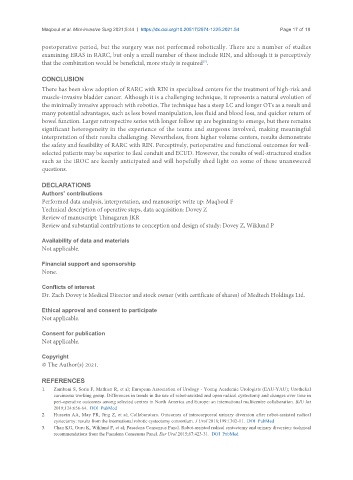Page 470 - Read Online
P. 470
Maqboul et al. Mini-invasive Surg 2021;5:44 https://dx.doi.org/10.20517/2574-1225.2021.54 Page 17 of 19
postoperative period, but the surgery was not performed robotically. There are a number of studies
examining ERAS in RARC, but only a small number of these include RIN, and although it is perceptively
[7]
that the combination would be beneficial, more study is required .
CONCLUSION
There has been slow adoption of RARC with RIN in specialized centers for the treatment of high-risk and
muscle-invasive bladder cancer. Although it is a challenging technique, it represents a natural evolution of
the minimally invasive approach with robotics. The technique has a steep LC and longer OTs as a result and
many potential advantages, such as less bowel manipulation, less fluid and blood loss, and quicker return of
bowel function. Larger retrospective series with longer follow up are beginning to emerge, but there remains
significant heterogeneity in the experience of the teams and surgeons involved, making meaningful
interpretation of their results challenging. Nevertheless, from higher volume centers, results demonstrate
the safety and feasibility of RARC with RIN. Perceptively, perioperative and functional outcomes for well-
selected patients may be superior to ileal conduit and ECUD. However, the results of well-structured studies
such as the iROC are keenly anticipated and will hopefully shed light on some of these unanswered
questions.
DECLARATIONS
Authors’ contributions
Performed data analysis, interpretation, and manuscript write up: Maqboul F
Technical description of operative steps, data acquisition: Dovey Z
Review of manuscript: Thinagaran JKR
Review and substantial contributions to conception and design of study: Dovey Z, Wiklund P
Availability of data and materials
Not applicable.
Financial support and sponsorship
None.
Conflicts of interest
Dr. Zach Dovey is Medical Director and stock owner (with certificate of shares) of Medtech Holdings Ltd.
Ethical approval and consent to participate
Not applicable.
Consent for publication
Not applicable.
Copyright
© The Author(s) 2021.
REFERENCES
1. Zamboni S, Soria F, Mathieu R, et al; European Association of Urology - Young Academic Urologists (EAU-YAU); Urothelial
carcinoma working group. Differences in trends in the use of robot-assisted and open radical cystectomy and changes over time in
peri-operative outcomes among selected centres in North America and Europe: an international multicentre collaboration. BJU Int
2019;124:656-64. DOI PubMed
2. Hussein AA, May PR, Jing Z, et al; Collaborators. Outcomes of intracorporeal urinary diversion after robot-assisted radical
cystectomy: results from the international robotic cystectomy consortium. J Urol 2018;199:1302-11. DOI PubMed
3. Chan KG, Guru K, Wiklund P, et al; Pasadena Consensus Panel. Robot-assisted radical cystectomy and urinary diversion: technical
recommendations from the Pasadena Consensus Panel. Eur Urol 2015;67:423-31. DOI PubMed

